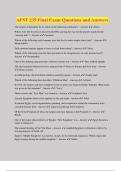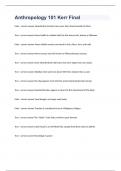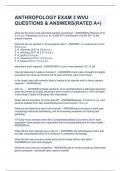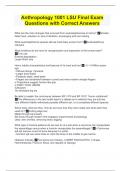Homo habilis Guides d'étude, Notes de cours & Résumés
Vous recherchez les meilleurs guides d'étude, notes d'étude et résumés sur Homo habilis ? Sur cette page, vous trouverez 109 documents pour vous aider à réviser pour Homo habilis.
Page 3 sur 109 résultats
Trier par

-
AFST 235 Final Exam Questions and Answers
- Examen • 6 pages • 2024
-
Disponible en pack
-
- €10,60
- + en savoir plus
AFST 235 Final Exam Questions and Answers The origins of humanity lie in which of the following continents? - Answer ️️ -Africa Where were the first fossils discovered(1856)- paving the way for the greater search for the "missing link"? - Answer ️️ -Germany Which of the following early humans were the first to make simple stone tools? - Answer ️️ - Homo habilis Fully modern humans appear to have evolved from where? - Answer ️️ -Africa Which of the following were the firs...

-
ANTHROPOLOGY EXAM 3 WVU QUESTIONS WITH VERIFIED SOLUTIONS.
- Examen • 9 pages • 2024
-
- €10,60
- + en savoir plus
ANTHROPOLOGY EXAM 3 WVU QUESTIONS WITH VERIFIED SOLUTIONS. What makes us human? - answerBipedalism, brains, skulls, Childhood dependency, tools, teeth biopedalism - answerstresses the advantages it provided in a habitat increasingly dominated by dry, savanna-like conditions. Brains and skulls - answerEarly hominins had very small brains, Brain size has increased during hominin evolution, especially with the advent of the genus Homo. Childhood dependency - answerCompared with the young o...

-
Anthropology 101 Kerr Final with 100% correct answers
- Examen • 8 pages • 2024
-
Disponible en pack
-
- €13,83
- + en savoir plus
Anthropology 101 Kerr FinalFalse - correct answer Neanderthal remains have never been found outside of Africa True - correct answer Homo Habilis is credited with the first stone tools, known as Oldowan False - correct answer Homo Habilis remains are found in Asia, Africa, Java, and India True - correct answer Homo erectus was first known as Pithecanthropus erectus True - correct answer Some Neanderthals had brains that were larger than ours today True - correct answer Obsidian too...

-
AFST 235 Final Exam Actual Questions and Answers Graded A+
- Examen • 7 pages • 2024
-
Disponible en pack
-
- €10,60
- + en savoir plus
AFST 235 Final Exam Actual Questions and Answers Graded A+ The origins of humanity lie in which of the following continents? - answerAfrica Where were the first fossils discovered(1856)- paving the way for the greater search for the "missing link"? - answerGermany Which of the following early humans were the first to make simple stone tools? - answerHomo habilis Fully modern humans appear to have evolved from where? - answerAfrica Which of the following were the first specimen to be r...

-
Test Bank for an Introduction to Brain and Behavior 5th Edition Bryan Kolb
- Examen • 163 pages • 2023
-
- €17,06
- + en savoir plus
Test Bank for an Introduction to Brain and Behavior 5th Edition Bryan Kolb 1. Brain abnormalities can be related to: A) B) C) D) 500 disorders. 1000 disorders. 1500 disorders. more than 2,000 disorders. 2. All the nerve processes radiating out beyond the brain and spinal cord as well as all the neurons outside the brain and spinal cord constitute the: A) B) C) D) nervous system. central nervous system. peripheral nervous system. external nervous system. 3. Which is NOT part of the peripher...

-
Anthropology Final-ANT 100 Lacquament Exam Questions and Answers 100% Pass
- Examen • 14 pages • 2024
-
Disponible en pack
-
- €11,53
- + en savoir plus
Anthropology Final-ANT 100 Lacquament Exam Questions and Answers 100% Pass _ consists of traditions and customs, transmitted through learning, that form and guide the beliefs and behavior of a group of people. - Answer- Culture Cultural Anthropology - Answer- Study of human society and culture Archaeology - Answer- Study of human behavior through material remains Biological Anthropology - Answer- Study of human biological variation through time and as it exists today linguistics - Answer...

-
ANTHROPOLOGY EXAM 3 WVU QUESTIONS & ANSWERS(RATED A+)
- Examen • 7 pages • 2024
-
Disponible en pack
-
- €11,07
- + en savoir plus
what are the three most important hominin evolutions? - ANSWERthe Pliocene (5 to 2 m.y.a.), Pleistocene (2 m.y.a. to 10,000 B.P.) and Recent (10,000 B.P. to the present) epochs What are the six species in chronological order? - ANSWER1. A. anamensis (4.2 to 3.9 m.y.a.). 2. A. afarensis (3.8? to 3.0 m.y.a.). 3. A. africanus (3.0? to 2.0? m.y.a.). 4. A. garhi (2.5 m.y.a.) 5. A. robustus (2.0? to 1.0? m.y.a.). 6. A. boisei (2.6? to 1.0 m.y.a.). afarensis's brain capacity - ANSWER450 cc ...

-
Abeka Biology Final Exam (Chapters 1- 24) Already Passed
- Examen • 10 pages • 2024
-
Disponible en pack
-
- €9,22
- + en savoir plus
Abeka Biology Final Exam (Chapters 1- 24) Already Passed Deciduous Trees that lose their leaves each fall Xylem The tissue that transports water and dissolved minerals upward from the roots Stamen The organs that produces pollen Osmosis The one-way diffusion through a semipermeable membrane Kingdom, phylum, class, order, family, genus, species The order of classification Epidermis The part of the skin that is exposed to the environment Louis Pasteur His experiments showed...

-
WGU Academy Intro to Bio Final with complete solution graded A+
- Examen • 10 pages • 2023
-
Disponible en pack
-
- €5,07
- + en savoir plus
Homo habilis - Shorter than modern. Large brains with large speech regions. They came from Australopithecines Homo floresiensis - coexisted with modern homo sapiens, but were much smaller in stature, most likely due to island dwarfing. Cro-Magnons - traveled from Africa to Western Europe around 40,000 years ago and may have been first hominids to have language Neandertals - larger brains than modern humans, larger muscles, shorter/thicker bones, massive brow ridges and wide, flat noses P...

-
Anthropology 1001 LSU Final Exam Questions with Correct Answers
- Examen • 9 pages • 2024
-
Disponible en pack
-
- €8,76
- + en savoir plus
What are the main changes that occurred from australopithecines to Homo? Smaller, flatter face; reduction in size of dentition; scavenging and tool making What australopithecine species did we most likely evolve from? Australopithicus robustus What evidence do we have for reorganization and expansion of the human brain? Tool use Enamel degradation Larger Brain size Homo habilis characteristics and features of its hand and foot • 2-1.4 Million years ago • Olduvai Gorge, Tanzania • Larger...

Ce résumé que vous venez d'acheter a fait très plaisir à quelqu'un. Vous voulez aussi être payé chaque semaine ? Vendez vos documents d'étude sur Stuvia ! Découvrez tout sur gagner de l'argent sur Stuvia


